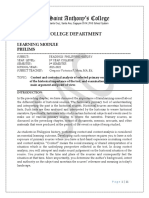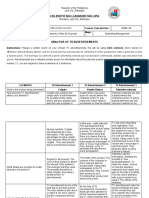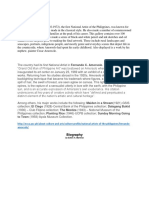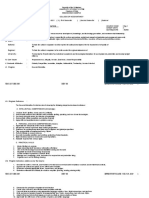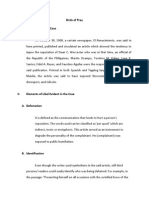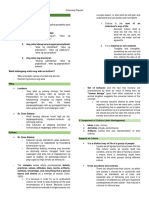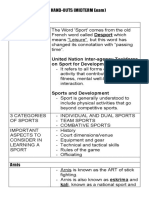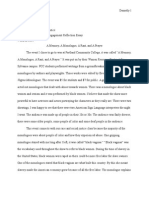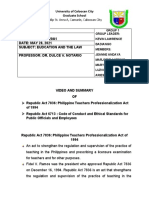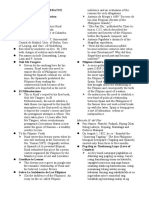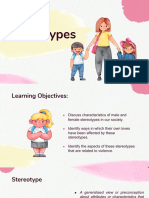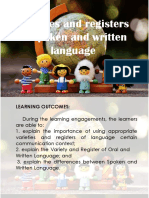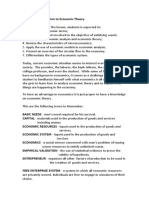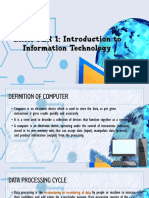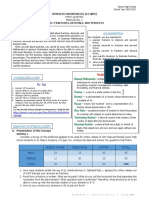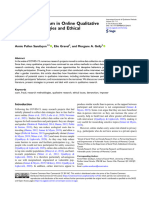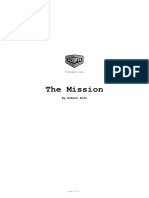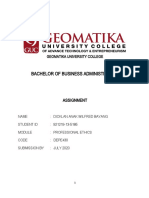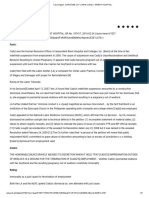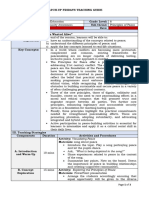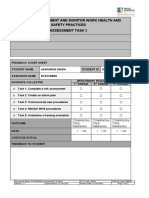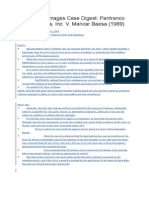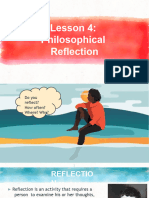Module 1 BSSW 2B
Uploaded by
Joseah Mae SaenzModule 1 BSSW 2B
Uploaded by
Joseah Mae SaenzENGLISH LANGUAGE DEPARTMENT
COLLEGE OF ARTS AND LETTERS
BICOL UNIVERSITY
LEGAZPI CITY
FIRST SEMESTER
ACADEMIC YEAR 2020-2021
PROPERTY OF:
__________________________________________________
NAME OF STUDENT/COURSE AND YEAR
GEC-15, PURPOSIVE COMMUNICATION Module 1
FORMAT FOR TASKS
Save all tasks in a letter-size or short bond paper [.docx or .doc format] and rename the
file using this format (M1-BSSW -Block B - Surname & Initials). Send your work to my e-
mail add: [email protected]
Name: __________________________ Course & Year: ______
TASK # 1
_____________________________________________________________________________________
_____________________________________________________________________________________
_____________________________________________________________________________________
_____________________________________________________________________________________
_____________________________________________________________________________________
_____________________________________________________________________________________
_____________________________________________________________________________________
_____________________________________________________________________________________
_____________________________________________________________________________________
_____________________________________________________________________________________
_____________________________________________________________________________________
_____________________________________________________________________________________
_____________________________________________________________________________________
_____________________________________________________________________________________
______________________________________________________________________________
TASK # 2
GEC-15, PURPOSIVE COMMUNICATION Module 1
TASK # 3
______________________________________________________________________________
_____________________________________________________________________________________
_____________________________________________________________________________________
_____________________________________________________________________________________
_____________________________________________________________________________________
_____________________________________________________________________________________
_____________________________________________________________________________________
_____________________________________________________________________________________
_____________________________________________________________________________________
_____________________________________________________________________________________
_____________________________________________________________________________________
_____________________________________________________________________________________
_____________________________________________________________________________________
TASK # 4
TASK # 5
______________________________________________________________________________
_____________________________________________________________________________________
_____________________________________________________________________________________
_____________________________________________________________________________________
_____________________________________________________________________________________
_____________________________________________________________________________________
_____________________________________________________________________________________
_____________________________________________________________________________________
_____________________________________________________________________________________
_____________________________________________________________________________________
_____________________________________________________________________________________
_____________________________________________________________________________________
_____________________________________________________________________________________
GEC-15, PURPOSIVE COMMUNICATION Module 1
INTRODUCTION
Humans’ capability to communicate using the inscribed words and use of sounds
make us top of the hierarchy of all living creatures.
Communication is derived from a Latin word “communis” which means common.
Communicating becomes essential in the human civilization on exchanging of
information, sharing thoughts, and expressing oneself. Also, it becomes the catalyst for
the people in the society to unite in decision making, and fostering good relationships
and profound respect to one another. Meanwhile, it is already known that the vital role
of communication is the transmission of message to other person, but how does
communication take place?
The process of communications happens between a sender and the receiver.
The message is encoded by the sender and decoded by the receiver channeling
through various medium. Most commonly, communication takes in face-to-face
interaction, however, as the world becomes more advanced, our means of
communications changes. Whilst the traditional modes of communication remain the
same, various communication modes arose and became not just the trend but become
essential in exchanging information. Communication mode refers to the channel through
which one expresses his/her communicative intent; it is the medium through which one
conveys his/her thoughts. Moreover, views or feeling can be communicated through
face-to-face interaction, video or audio. Thus, the development of various channel for
communication using the Ethernet and Information and Communication Technology
allow us transfer the message faster and convenient. Needless to say, the transmission
of the information is also interrupted by many barriers of communication thus, affecting
and hindering the understanding of both parties due to noise and other subconscious
nonverbal cues. More often or not, nonverbal signals trigger the process of
communication.
Additionally, written communication has become important on the academic
arena. Through written text information, it allows us to discover, explore, travel the
world, and seemingly defy time and space. Analyzing the deeper context of diverse
cultures in our community serves a key point of human intellect on unveiling the
significant details of the evolution of human, diversities, cultures, politics, and society.
Thus, becomes a primary tool on the academic research and the like.
Essentially, this module does not only contain the types, basic elements,
process, modes, and forms of communication as it also includes the different purposes
of communication in the daily course of human person and how one’s good
communication skills effect on the society. The underlying purpose of communication
also is to cross the culture of other people in a holistic level of perception and
determining the differences through understanding multicultural communication and
globalization trend.
Therefore, adept communication skills and embodying the ethical principles of
communication help us to converse and transmit the message effectively to our target
audience. Furthermore, it hones our moral and intellectual capacity making as not just a
good communicator but a listener as well, thus avoiding and mitigating
misunderstanding and further implications of both parties in the actual scenario of
communication.
GEC-15, PURPOSIVE COMMUNICATION Module 1
PRELIMINARY LESSON
VISION & MISSION OF BICOL UNIVERSITY
WHAT IS THIS LESSON ABOUT?
In this preliminary lesson, I will introduce you to the vision and mission of Bicol
University (BU). I will also show you the expected attributes of a BU graduate, so that
you will know what is expected of you after you finish your degree program.
In addition, during this week, you are tasked to introduce yourself to the class
and know the class rules. These rules are contained in the course guide that I expect
you have read before going through this module.
WHAT WILL YOU LEARN?
At the end of this lesson, you are expected to:
1. Be able to discuss the vision and mission of the university in relation to your
degree program (BACHELOR OF SCIENCE IN SOCIAL WORK)
2. Relate the attributes of a BU graduate to one’s self, pursuant to the aim of
becoming a world class university.
LET’S READ!
The vision of BU: A world-class university producing leaders and change agents
for social transformation and development
The mission of BU: Give professional and technical training, and provide
advanced and specialized instruction in literature, philosophy, the sciences, and arts
besides providing for the promotion of scientific and technological researches (Republic
Act 5521, Section 3.0)
Every BU graduate should:
1. Demonstrate critical thinking and integrative skills to solve problems and to
support lifelong learning
2. Communicate effectively and appropriately orally and in writing for various
purposes with the responsible use of ICT tools
3. Collaborate with diverse people ethically and with mastery of knowledge and
skills in given disciplines
4. Create knowledge and innovation to promote inclusive development, as well as
globalization.
GEC-15, PURPOSIVE COMMUNICATION Module 1
BU QUALITY POLICY:
Bicol University commits to continually strive for excellence in instruction,
research and extension by meeting the highest level of clientele satisfaction and
adhering to quality standards and applicable statutory and regulatory
requirements.
TASK #1
For this task, write a one-paragraph essay of not
more than 200 words explaining how you as BSSW student
can help BU attain its vision.
TASK #2
Create a meme on how you can be a change agent
that would lead to social transformation. Use your own
picture and template. I would expect an original creation.
Your work will be rated following the rubric below.
Rubric for Rating:
Concept (Relevance to the topic) 40%
Creativity 30%
Originality 30%
Total 100%
GEC-15, PURPOSIVE COMMUNICATION Module 1
CHAPTER ONE
COMMUNICATION PROCESSES, PRINCIPLES & ETHICS
WHAT IS THIS LESSON ABOUT?
This lesson will focus on a review on the definition of communication, its
processes and the ethics it entails. It is important that we gain higher familiarity on the
subject of communication as a concept, phenomenon, and as an inevitable human
activity so that we become effective and responsible communicators.
WHAT WILL YOU LEARN?
At the end of this lesson, you are expected to:
1. Increase knowledge in communication, its processes and principles hence
become more skillful communicators;
2. Heighten awareness on communication ethics resulting in conscientious and
respectful interactions; and
3. Apply the gained knowledge in communication processes, principles and
ethics through class exercises that will help you execute expected
communication performances.
GEC-15, PURPOSIVE COMMUNICATION Module 1
• Think of words or phrases that can be associated with
“communication.”
• Answer briefly the following questions on the space below:
a. What does communication mean? How important is
communication to your personal and professional
success?
b. Use a semantic web to clearly show the relationships
of ideas on communication.
a. ________________________________________________________________________
________________________________________________________________________
________________________________________________________________________
________________________________________________________________________
________________________________________________________________________
________________________________________________________________________
________________________________________________________________________
________________________________________________________________________
________________________________________________________________________
b.
Communication
GEC-15, PURPOSIVE COMMUNICATION Module 1
LESSON 1: COMMUNICATION, IMPORTANCE & PROCESS
LET’S READ!
COMMUNICATION is a human act of sending (verbal or nonverbal; online or offline) and
receiving of messages where interpretations are normally constructed in the process. It
is a natural activity of people. We are always engaged in almost all sorts of
communication. As Walzlawick (1976 in Øyvind, et al., 2011), a communication expert,
aptly wrote, “One cannot communicate.” Apparently, all human beings are wired for
communication activities in one’s lifetime.
Studying communication therefore enables us to have a good grasp of this unavoidable
human activity and hopefully makes us good and responsible participants. By being
good participants means that as senders and receivers of messages, a common
understanding is achieved, resulting in a successful communication.
WHAT THEN IS PURPOSIVE COMMUNICATION?
PURPOSIVE COMMUNICATION is an intentional communication that happens within
the bounds of specific contexts.
CONTEXT. Communication happens in specific contexts. Context includes settings or
environment (family, school, workplace, religious communities); social relations (friends,
husband and wife, parent and child, colleagues/boss-subordinate in the office; scenes
which include place, time and occasion (business meeting, job interview, social
gathering – parties, weddings, etc.) and culture (history, tradition, beliefs, norms,
values).
Contexts are vital considerations in our communication acts since they affect the
process of sending and receiving of messages; semantics or meanings; choice of
channels, words and methods of delivery. Communication therefore must be suitable to
the specific context hence should be intentional or purposive.
It is therefore logical to explain purposive communication as a communication applied in
a specific setting, environment, scene, socials relations and culture.
In your oral communication course in senior high school, you were introduced to the
different elements (sender, receiver, message, barriers/noise, channels, and feedback)
models (linear, interactional and transactional) and functions (social interaction,
information, emotional expression, motivation & regulation) of communication. It is
advisable to do a review of these communication principles so that in this course, we can
already focus on expanding our knowledge of the field and immerse ourselves in various
contexts wherein these communication events occur.
COMMUNICATION AS A PROCESS
COMMUNICATION is a process whereby people create and transmit meaning through
the exchange of verbal and nonverbal messages in a particular context (Oetzel,
2009:11).
Since communication is a process, it is something continuous (e.g., an argument that is
extended for several months, an exchange of messages between officemates, etc.)
there are times however that we terminate our communication with someone or a group
when we already lose the purpose or goal in communicating with the participant/s.
Nevertheless, even if one does not anymore consciously make an effort to converse or
interact with the other person, this is still an act of communication as this sends
GEC-15, PURPOSIVE COMMUNICATION Module 1
messages such as “I don’t want to associate with you anymore…” or simply “there is no
more reason that we should be talking.”
Hence, communication may not have a definite end.
GEC-15, PURPOSIVE COMMUNICATION Module 1
LESSON 2: REVIEW ON THE BASIC PRINCIPLES OF
COMMUNICATION
LET’S READ!
SENDER
The SENDER of the message is a highly important element being the source of the idea. As the
sender, it is expected that one possesses the skills required in transmitting messages. These
skills could include the ability to use the language that the receiver understands. For instance, it
will be inept to use the English language if your audience is keener on using their local language
in a Philippine or Asian setting. Along with using the appropriate language is the application of
linguistic features such as correct grammar, phonetics (for spoken messages); choice of words
or jargons for an appropriate audience; sentence construction; and discourse competence. The
sender’s credibility is of great importance as well. People will more likely reject a message if the
sender is proven to be unreliable. The message will only be as good and valid as its source.
DELIVERY
This is an equally important skill that a sender should be able to exhibit properly. In oral
communication, this could include good voice projection, use of appropriate eye contact, proper
articulation of words, and emphasis on important words. Delivery could also include using the
appropriate intonation in order to avoid misunderstanding on the part of the listener/receiver or
conflict between the interlocutors. For instance, a high pitch intonation or an overly emphatic
tone might be offensive to a listener; hence, the speaker should be mindful of the manner of
delivery.
RECEIVER
Receiver of messages must have good listening and comprehension skills. Good listening
requires one to focus on what is conveyed and as much as possible eliminate all possible
distractions or noises (physical, environmental, psychological, emotional) that would hinder one
from understanding the message. On the other hand, good comprehension skills necessitate
sharpness of cognition, which can be achieved through continuous studies and acquisition of
information and knowledge.
Also, the receiver’s prejudice could possibly affect one’s receptiveness towards the message.
For example, if a receiver dislikes the sender, the former is more likely to be sceptical towards
whatever message the latter relays. It is therefore advisable to listen/read objectively and set
aside biases to avoid erroneous interpretations.
GEC-15, PURPOSIVE COMMUNICATION Module 1
MESSAGE
For messages to be accurately understood and positively received, the C’s in communication
may be followed:
COURTESY. Another word for courtesy is politeness. Usage of polite words and tone
means one respects the receiver of the message. Tact and diplomacy in communication
is always appreciated and this approach will normally beget a positive reply. Developing
the “we” attitude, using positive words instead of negative, being considerate of the
feelings of the receiver, selecting gender-free terms and responding promptly to
important messages are ways to demonstrate courtesy.
CLARITY. This may involve correct word usage, grammar, pronunciation, sentence
construction and delivery. Messages which are unclear oftentimes do not achieve their
desired effect.
CONCISENESS. Lengthy messages can result in information overload and overwhelm
listeners/readers of messages. Conciseness is “saying what needs to be said in as few
words as possible.” To display conciseness, flowery languages, which normally include
unnecessary words must be avoided. Remember, our goal is to communicate and not to
impress our listeners/readers with our lengthy discourse.
CONCRETENESS. This refers to being specific. To demonstrate concreteness,
providing examples whenever necessary makes a message more comprehensible.
COMPLETENESS. To avoid ambiguity, messages should not leave out important details
that a receiver expects to know such as answers to the WHAT, WHO, WHEN, WHERE,
WHY, and HOW questions.
THE IMPORTANCE OF FEEDBACK
Messages in communication will always have an effect on the receiver. There are
messages that trigger positive reactions and at times negative depending on the kind of
message relayed, how it is communicated and how it is interpreted. It is therefore important
to know the feedback of our audience/s (listener/reader) in order to make the necessary
clarifications and revisions of our messages.
CHANNELS
GEC-15, PURPOSIVE COMMUNICATION Module 1
The 21st century has introduced communication technologies (smart phones, tables,
computers) as popular channels in addition to the older forms such as traditional
telephone, radio, television and printed texts (books, newspapers, magazines, journals,
posters, etc.).
The choice of a channel may depend on the availability, practicality, and its impact on
the receiver. For instance, in communicating with our loved ones abroad, using our smart
phones, tablets or computers are deemed practical and convenient. For those living in
areas where internet connection is unavailable, traditional telephones are still very useful. In
the acquisition of information on the other hand, many rely on printed texts. Television has
also been a popular channel for information and entertainment while radio remains popular
especially in certain areas of the provinces.
BARRIERS AND NOISE
In your previous studies in communication, experts assert that noise or barriers in
communication maybe due to environmental, physical, psychological and emotional
conditions. Other than these aspects, differences in language, gender and culture can also be a
barrier in communication.
For communication to be effective, these barriers/noise should be mitigated or if possible
eliminated. Gender and culture differences as communication barriers however can be more
challenging to control and could not be eliminated. What one can at least do is to acknowledge
these gender differences in communication, compromise in certain areas, meet halfway and
maintain respect to each other’s points of view.
GEC-15, PURPOSIVE COMMUNICATION Module 1
TASK #3
Create a dialogue showcasing a
communication problem and how said problem is
resolved.
GEC-15, PURPOSIVE COMMUNICATION Module 1
LESSON 3: PURPOSES OF COMMUNICATION
LET’S READ!
Various information and meaning are conveyed when people communicate with each other.
People may use language, which is a system of symbols in communicating. These symbols can
either be written or spoken.
Communication is considered as one of the basic activities of human beings, which may be
used for varied purposes. Communication can be informative, affective, imaginative, persuasive
and ritualistic.
Informative communication pertains to the presentation of messages that are objective, truthful
and unbiased.
Affective communication takes place when people express their positive and negative feelings
about people, circumstances, or events.
Imaginative communication takes place when people express their appreciation on fictional
messages from books, films and conversation.
Persuasive communication, on the other hand, takes place when people attempt to influence
the beliefs or actions of others.
Ritualistic communication is done when people are able to meet social expectations.
WHY DO PEOPLE COMMUNICATE?
Communication is a part of everyone’s life; people from every walks of life communicate. They
do so to express their feelings, opinion, aspirations, dreams, fears, apprehensions or regrets in
life. Humans are creative beings, and they know how to communicate in various and creative
ways through verbal, nonverbal, linguistic or non-linguistic cues.
Specifically, people communicate in order to INFORM, EVOKE, ENTERTAIN, ARGUE and
PERSUADE.
TO INFORM TO EVOKE TO TO ARGUE TO
ENTERTAIN PERSUADE
To INFORM is to To EVOKE means To ENTERTAIN is To ARGUE is to To PERSUADE is
impart knowledge, to rely on passion to transmit a persuade, to to move the
to clarify and controversy to feeling of pleasure assent to the listeners to action.
information, and make a point. and goodwill to plausibility of the The
GEC-15, PURPOSIVE COMMUNICATION Module 1
to secure Evocative the audience. The communicator’s communicator
understanding. communication communicator is side of a should demolish
centers on considered debatable the listener’s
controversial topics gracious, genial, question. The objection and
that typically use
emotion to make a
good-natured, speaker’s purpose prove the
point. It must show relaxed and is to appeal to the acceptability of his
a lot of enthusiasm demonstrates to intellect of his or or her argument
and concern for the his or her listeners her listeners so or position.
topic and must use the pleasant job of that they will be
personal experience speaking to them. convinced.
to draw the
audience. Using
government
researches,
statistics and data
can all help make
their topics more
believable and more
engaging.
INFO CORNER!
KINDS OF SPEECH ACCORDING TO PURPOSE
According to Osborn & Osborn (1988), an
informative speech gives rather than asks
INFORMATIVE SPEECH or takes. The demands on the audience
are low, as the listeners are asked to
attend, to comprehend, to understand, to
assimilate, but not to change their beliefs
and behaviours.
Gronbeck (1994) explains that persuasive
PERSUASIVE SPEECH speaking is the process of producing oral
messages that increase personal
commitment, modify beliefs, attitudes or
values.
This is a speech that aims to persuade
ARGUMENTATIVE SPEECH the audience to assent to the plausibility
of the speaker’s side of a debatable
question.
KINDS OF SPEECH ACCORDING TO DELIVERY
Reading from a manuscript is a manner
READ SPEECH of speaking where a written speech is
read and delivered word for word.
This is a written speech which is
mastered and delivered entirely from
MEMORIZED SPEECH memory. This kind of speech requires the
speaker a considerate memory skill in
order not to forget his or her presentation.
This is a speech where the speaker
IMPROMPTU SPEECH develops his or her ideas, thoughts and
language at the moment of delivery.
This is a speech where the topics or
EXTEMPORANEOUS SPEECH ideas are prepared beforehand; however,
the speaker will compose his or her views
and language only at the moment of
delivery.
GEC-15, PURPOSIVE COMMUNICATION Module 1
LESSON 4: TYPES OF COMMUNICATION
LET’S READ!
A message may be impart through these types; verbal-non-verbal and visual. While
communication is often thought of as verbal, the non-verbal mode is equally essential as it
enhances one‘s message.
ACCORDING TO MODE:
VERBAL-NONVERBAL COMMUNICATION
Effective communication calls for the blending of these two types. One cannot be separated
from the other. For example, door-to-door sales persons who demonstrate product knowledge
can only be effective if they know how to properly punctuate what they say with proper gestures
and facial expressions. Their communication with the customer begins upon greeting him/her
with a welcoming smile then assessing customer needs and answering customer queries
enhanced by gestures and a friendly, happy and pleasant disposition. It is through this mode
that sales pole with excellent communication skills are able to provide the best information
needed, by that means convincing the client to patronize their products.
NONVERBAL COMMUNICATION
Communication includes gestures, facial expressions and even silence. Silence could
have variety of meanings depending on the racial culture. For instance, according to study,
Japanese doctors during conversations with their patients use silence and pauses (30% of
the conversation) to express respect and as a way of showing that they are contemplating
on what has been shared by their patients. On the other hand, silence may only comprise 8% of
the conversation time between American doctors and their patients. While some cultures
view silence as a sign of respect to the conversation partners, others see silence as a lack of
interest or a sign of disagreement.
VISUAL COMMUNICATION
GEC-15, PURPOSIVE COMMUNICATION Module 1
Visual communication, on the other hand, is the type of communication that uses visuals to
convey information and/or messages. Some examples are signs, symbol, imagery, maps,
graphs, charts, diagrams, pictograms, photos, drawings or illustrations, and even various forms
of electronic communication. Visual communication now occupies an important place in any
work environment. For instance, during presentations, instructors, managers, doctors, lawyers,
legislators and the like use visuals to transfer data into digestible information. Very likely, they
have greater success in catching the attention of the audience making the latter easily recall the
information.
What makes visual communication even more advantages is that it makes use of
communication even more advantages is that it makes use of technology that provides
apps( applications), videos and images that rely less on the printed word making presentations
more interesting. This leaves a powerful effect on the audience and prospective clients.
Speakers/presenters should be mindful of the content of their presentation since wrong and
irrelevant information may lead to miscommunication. Likewise, they should pay attention to
graphic elements, such as position, color, size, shape and orientation as all these play an
important role in the presentation of slides. Audience size should be considered as well when
preparing slide presentations or other forms of visuals.
ACCORDING TO CONTEXT
In this sub-section, context in communication is referred to as composite of people interacting
with each other. Communication may also be classified according to context: (1) intrapersonal;
(2) interpersonal.
INTRAPERSONAL COMMUNICATION: The Latin prefixes intra-means within or inside.
Intrapersonal communication then means talking to oneself. Some label it as self or inner talk,
inner dialogue. Psychologists call it with other names such as self-verbalization or self-
statement. Intrapersonal communication can be defined also as communication with one‘s self, and that
may include self-talk, acts of imagination and visualization, and even recall and memory (McLean, 2005).
You read on your phone that your friends are going to have dinner at your favorite restaurant. What
comes to mind? Sights, sounds, and scents? Something special that happened the last time you were
there? Do you contemplate joining them? Do you start to work out a plan of getting from your present
___location to the restaurant? Do you send your friends a text asking if they want company? Until the
moment when you hit the ―send‖ button, you are communicating with yourself.
Communications expert Leonard Shedletsky examined intrapersonal communication through the eight
basic components of the communication process (i.e., source, receiver, message, channel, feedback,
environment, context, and interference) as transactional, but all the interaction occurs within the
individual (Shedletsky, 1989). From planning to problem solving, internal conflict resolution, and
evaluations and judgments of self and others, we communicate with ourselves through intrapersonal
communication. All this interaction takes place in the mind without externalization, and all of it relies on
previous interaction with the external world.
INTERPERSONAL COMMUNICATION: Interpersonal communication can be defined as
communication between two people, but the definition fails to capture the essence of a relationship. This
broad definition is useful when we compare it to intrapersonal communication, or communication with
ourselves, as opposed to mass communication, or communication with a large audience, but it requires
clarification.
The developmental view of interpersonal communication places emphasis on the relationship rather than
the size of the audience, and draws a distinction between impersonal and personal interactions. Family for
many is the first experience in interpersonal relationships, but as we develop professionally, our
relationships at work may take on many of the attributes we associate with family communication. We
look to each other with similar sibling rivalries, competition for attention and resources, and support. The
GEC-15, PURPOSIVE COMMUNICATION Module 1
workplace and our peers can become as close, or closer, than our birth families, with similar challenges
and rewards. To summarize, interpersonal relationships are an important part of the work environment.
LESSON 5: COMMUNICATION MODELS
LET’S READ!
Communication models are systematic representations of the process which helps in
understanding how communication works can be done. Models show the process
metaphorically and in symbols. They form general perspectives on communication by breaking
communication from complex to simple and keeps the components in order. Communication
models can sometimes encourage traditional thinking and stereotyping but can also omit some
major aspects of human communication.
Methods and channels of communication to be used and the purpose of communication, must
be considered before choosing a specific communication model. Models are used by business
companies and other firms to foster their communication, explore their options and to
evaluate their own situations. It is also used to understand how the receivers will interpret the
message.
Types of Communication Model
There are three general types of communication models in which all other communication
models are mostly categorized.
GEC-15, PURPOSIVE COMMUNICATION Module 1
Linear Model of Communication
Linear model of communication is a simple one way communication model. The message flows
in a straight line from sender to the receiver. There is no concept of feedback. The only task that
a receiver does here is to receive the message. Different models that follow linear model of
communication are:
Lasswell’s Model
Aristotle’s Model
Shannon Weaver Model
Berlo’s S-M-C-R Model
Transactional Model of Communication
In transactional model, senders and receivers both are known as communicators and both play
equally important role in communication. Transactional model relates communication with social
reality, cultural up-bringing and relational context (relationships). Non-verbal feedback like
GEC-15, PURPOSIVE COMMUNICATION Module 1
gestures, body language, is also considered as feedback in this model. Different models that
follow transactional model of communication are:
Barnlund’s Transactional Model
Helical Model
Becker’s Mosaic Model
Interactive Model of Communication
Interactive model or convergence model is similar to transactional model as they are both two
way communication model. But, interactive model is mostly used for new media like internet.
Here, people can respond to any mass communications like videos, news, etc. People can
exchange their views and ideas. Different models that follow interactive model of communication
are:
Schramm’s Interactive Model
Source: https://businesstopia.b-cdn.net/wp-content/uploads/2018/02/communication-model.jpg
TASK #4
Identify atleast three situations where transactional model of communication is
shown.
Context Sender- Message Channel Barriers
receiver
Example: school There should be Conference Noise,
School officials, tuition fee increase to culture,
administration- parents, upgrade school prejudices,
parent-student students facilities and to fund past
conference on student-teacher experiences,
tuition fee academic research,
language
increase student leadership
development, use
professional learning
for teachers, and
community extension
GEC-15, PURPOSIVE COMMUNICATION activities Module 1
1.
2.
LESSON 6: GENERAL PRINCIPLES OF EFFECTIVE
COMMUNICATION
LET’S READ!
GENERAL PRINCIPLES OF EFFECTIVE
COMMUNICATION
Know your purpose Know your
Know your topic
in communicating audience
Adjust your speech
or writing to the Work on the
context of the feedback given you
situation
Since communication is a two-way process, it is significant that you know the principles to
be observed to make it effective. For both oral and written communication, one should be
able to apply the following principles:
Know your purpose in communicating. Are you communicating basically to inform, to
entertain, or to persuade? While you may have more than one purpose, there is still a
more dominant objective or reason why you communicate.
Know your audience. In both speaking and writing, you should know your audience as it
will dictate the speaking or writing style you are going to employ. Consider the age,
educational background, profession, culture, and other salient features of your listeners
or readers.
Know your topic. You communicate essentially because you want to share something. In
speaking situations, speakers are invited because they have something to share. This
also applies to writing. You write because you wish that other people learn something
from you. You may then utilize several or multiple communication techniques to easily
catch the attention of the audience.
Adjust your speech or writing to the context of the situation. The environment in which
your speech or writing is to be delivered determines the kind of language you will use.
Work on the feedback given to you. Once you receive comments from the
listeners/readers, work on them. Take kindly to criticisms. In the long run, constructive
criticisms will prove beneficial to you as you learn to address them.
GEC-15, PURPOSIVE COMMUNICATION Module 1
PRINCIPLES OF EFFECTIVE ORAL COMMUNICATION
Be clear with your purpose. You should know by heart your objective in
communicating.
Be complete with the message you deliver. Make sure that your claims are
supported by facts and essential information.
Be concise. You do not need to be verbose or wordy with your statements. Brevity in
a speech is a must.
Be natural with your delivery. Punctuate important words with the appropriate
gestures and movements. Exude a certain degree of confidence even if you do not
feel confident enough.
Be specific and timely with your feedback. Inputs are most helpful when provided on
time.
LESSON 7: MAJOR FORMS OF COMMUNICATION
LET’S READ!
MAJOR FORMS OF COMMUNICATION
GEC-15, PURPOSIVE COMMUNICATION Module 1
There are 5 forms of communication:
1. Intrapersonal Communication- communication happens within the person. Hence, there
is no feedback and/or feedbacks are not interrupted.
Example: A person can communicate himself through praying.
2. Interpersonal Communication- communication happens between a group of persons.
Example: Ana is talking to Mrs. Maricar with regards to the school requirements.
3. Dyadic Communication- communication happens between two persons. Either way, the
source become the receiver and vice versa because of the dynamic and spontaneous flow of
discourse. One of the best examples of dyadic communication is between a patient and a
doctor.
4. Small Group Communication- this communication usually happen in an organizational
communization and involves more than two individuals. The information coming from the
source down to the receiver and vice versa. There is a continuous sending and receiving of
feedbacks.
5. Public Communication- this communication is a one way type model of communication
as it no longer requires the feedback of the receiver or the audience. The message of the
speaker will be sent to a huge number of audiences. For instance, public speaking like the
State of the Nation Address (SONA) of the president.
6. Mass Communication- this involves a large number of people and requires a tool to help
disseminating the information. This also no longer requires feedback from the audience to the
source. For instance, television news and advertisement. But in mass communication, there
is no direct access with the receiver. For that they need media like Newspaper, Radio,
Television and Internet. The audience feedback is very less or delayed.
When the message you convey are not communicated properly and felt guilty of not
conveying the message as it wants to be conveyed feels worse. It is because the effective
communication is being hindered by noise or in other reference, barriers. Some of the
barriers that obstructs effective communication include noise, inappropriate medium,
assumptions, emotion, and use of jargons or technical terms, and poor listening skills. These
barriers are categorized into five. Physical, Psychological, Cultural, Language Used, and
Personal.
LESSON 8: ETHICS OF COMMUNICATION
LET’S READ!
GEC-15, PURPOSIVE COMMUNICATION Module 1
The term ethics comes from the Greek word ethos, which means custom, habit,
character or outlook. Albeit peoples from different cultures vary in their moral
philosophies, people in general expect to be treated with dignity, fairness, respect or with
basic courtesy in the communication encounters.
Regardless of an individual’s moral principle (relativistic), ethics in communication can
take a universal approach, which can be displayed in several ways including but not
limited to the following:
1. Adhering to the Golden Rule or the Platinum Rule.
The golden rule asserts to always treat others in the same way you want to be
treated while the platinum rule according to Bennett (1980) stresses on treating
others the way they wish to be treated. Ethical communicators address people of
other cultures with the same respect that they would like to receive themselves
(Jandt, 2013:37).
2. Considering the feelings of the receiver.
Humans are not only cognitive but also emotional beings. If we are less careful with
our words, tone and nonverbal gestures, people could be negatively affected. To be
ethical in communicating with others, it will be best to maintain tact and diplomacy in
our communications.
3. Acknowledging the source of idea and information.
Sources of ideas and information should be acknowledged appropriately at all times.
It is unethical and unlawful for someone to convey other people’s intellectual property
without recognizing the author’s names or organizations.
4. Speaking the truth.
This is a universal rule. Unfortunately, there are also those who (for whatever
reason) seem to enjoy propagating falsehood. Take for instance the abundance of
fake news or what others call alternative facts on the internet. Obviously, this is a
violation of communication ethics and should be stopped by all means.
GEC-15, PURPOSIVE COMMUNICATION Module 1
TASK #5 In your own perspective, why is the study of
communication is relevant to your life and to your future
profession? Cite specific instances of its significance.
GEC-15, PURPOSIVE COMMUNICATION Module 1
You might also like
- LNC-WK.14-15 Communication For Academic PurposesNo ratings yetLNC-WK.14-15 Communication For Academic Purposes9 pages
- Kolehiyo NG Lungsod NG Lipa: Analysis of TV AdvertisementsNo ratings yetKolehiyo NG Lungsod NG Lipa: Analysis of TV Advertisements4 pages
- Reaction Paper 1 - Definition of GlobalizationNo ratings yetReaction Paper 1 - Definition of Globalization2 pages
- Child and Adolescent Development: A NarrationNo ratings yetChild and Adolescent Development: A Narration6 pages
- Approaches To Curriculum Design - Prof Ed 4 ReportNo ratings yetApproaches To Curriculum Design - Prof Ed 4 Report9 pages
- Epinoyload Product List September 19 2021No ratings yetEpinoyload Product List September 19 202128 pages
- Unit5. Documentation Monitoring Evaluation of NSTP Community Based ProjectsNo ratings yetUnit5. Documentation Monitoring Evaluation of NSTP Community Based Projects5 pages
- Lesson 3: The Self From The Perspective of Anthropology Anthropology Biological Anthropology100% (1)Lesson 3: The Self From The Perspective of Anthropology Anthropology Biological Anthropology3 pages
- United Nation Inter-Agency Taskforce On Sport For Development and PeaceNo ratings yetUnited Nation Inter-Agency Taskforce On Sport For Development and Peace5 pages
- School of Business: Philippine College Foundation100% (1)School of Business: Philippine College Foundation6 pages
- Technology For Teaching and Learning 2 (Technology in Secondary Language Education)No ratings yetTechnology For Teaching and Learning 2 (Technology in Secondary Language Education)21 pages
- Community Engagement Reflection Essay WinterNo ratings yetCommunity Engagement Reflection Essay Winter5 pages
- Lesson 7 Slides - Actors of Economic GlobalizationNo ratings yetLesson 7 Slides - Actors of Economic Globalization22 pages
- Awareness, Managing Emotions, Handling Anxiety, Motivating Themselves and Being Sensitive Towards OthersNo ratings yetAwareness, Managing Emotions, Handling Anxiety, Motivating Themselves and Being Sensitive Towards Others2 pages
- Asian Regionalism Intercontinental Drift Culture Media and GlobalizationNo ratings yetAsian Regionalism Intercontinental Drift Culture Media and Globalization9 pages
- Em19: Language and Literature Assessment: Bestlink College of The Philippines100% (1)Em19: Language and Literature Assessment: Bestlink College of The Philippines5 pages
- REFERENCE MATERIAL IN PROF ED 5. THE TEACHER AND THE COMMUNITY__No ratings yetREFERENCE MATERIAL IN PROF ED 5. THE TEACHER AND THE COMMUNITY__52 pages
- Dr. Jose P Rizal: 21 Century Literatue Philippine RevelationNo ratings yetDr. Jose P Rizal: 21 Century Literatue Philippine Revelation5 pages
- UE S A TT RI BU TE S C HM SC: Center For External AffairsNo ratings yetUE S A TT RI BU TE S C HM SC: Center For External Affairs18 pages
- Varieties and Registers of Spoken and Written LanguageNo ratings yetVarieties and Registers of Spoken and Written Language27 pages
- The Impact of a Deadly Pandemic on Individual, Society, Economy and the WorldFrom EverandThe Impact of a Deadly Pandemic on Individual, Society, Economy and the WorldNo ratings yet
- Lesson 1 Definition of Terms Basic MicroeconomicsNo ratings yetLesson 1 Definition of Terms Basic Microeconomics2 pages
- English Language Department College of Arts and Letters Bicol University Legazpi CityNo ratings yetEnglish Language Department College of Arts and Letters Bicol University Legazpi City12 pages
- KATHLEEN BONGAYAN Performance Task 1 Editorial WritingNo ratings yetKATHLEEN BONGAYAN Performance Task 1 Editorial Writing2 pages
- St. Mary's Academy of Ligao, Inc. Senior High School Ligao City SY 2020 - 2021No ratings yetSt. Mary's Academy of Ligao, Inc. Senior High School Ligao City SY 2020 - 20212 pages
- Pullen Sansfacon Et Al 2024 Dealing With Scam in Online Qualitative Research Strategies and Ethical ConsiderationsNo ratings yetPullen Sansfacon Et Al 2024 Dealing With Scam in Online Qualitative Research Strategies and Ethical Considerations11 pages
- ENTJ Personality (Commander) - 16personalitiesNo ratings yetENTJ Personality (Commander) - 16personalities6 pages
- Any Religious, National, or International Law Dealing With Engineering EthicsNo ratings yetAny Religious, National, or International Law Dealing With Engineering Ethics16 pages
- Gapminder Factfulness Instincts & Rules of ThumbNo ratings yetGapminder Factfulness Instincts & Rules of Thumb2 pages
- Faking - Radicalism - in - A - Global - Context201 (Suraj Yengde's CritiqueNo ratings yetFaking - Radicalism - in - A - Global - Context201 (Suraj Yengde's Critique4 pages
- Case Digest - CHRISTINE JOY CAPIN-CADIZ v. BRENT HOSPITALNo ratings yetCase Digest - CHRISTINE JOY CAPIN-CADIZ v. BRENT HOSPITAL3 pages
- SITXWHS003-Assessment 2 (JASKARAN AUSTRALIA ASSIGMENT DONE FREE HELP)No ratings yetSITXWHS003-Assessment 2 (JASKARAN AUSTRALIA ASSIGMENT DONE FREE HELP)21 pages
- Steps-Solutions-To-Ethical-Problems-In-Schools 1 1No ratings yetSteps-Solutions-To-Ethical-Problems-In-Schools 1 12 pages
- In A Tranquil Village Nestled Between Rolling Hills and Blooming MeadowsNo ratings yetIn A Tranquil Village Nestled Between Rolling Hills and Blooming Meadows2 pages
- Peshawar Electric Supply Company: Online Application FormNo ratings yetPeshawar Electric Supply Company: Online Application Form1 page
- Lesson 4 Philosophical Reflection For Hand OutsNo ratings yetLesson 4 Philosophical Reflection For Hand Outs12 pages
- ﺪــــﻋﻮـــﻣ ﺓﺮــﻛﺬــﺗ Appointment Slip: Medical Record No. Date Of Birth SEX ELG COVNo ratings yetﺪــــﻋﻮـــﻣ ﺓﺮــﻛﺬــﺗ Appointment Slip: Medical Record No. Date Of Birth SEX ELG COV2 pages
- Kolehiyo NG Lungsod NG Lipa: Analysis of TV AdvertisementsKolehiyo NG Lungsod NG Lipa: Analysis of TV Advertisements
- Approaches To Curriculum Design - Prof Ed 4 ReportApproaches To Curriculum Design - Prof Ed 4 Report
- Unit5. Documentation Monitoring Evaluation of NSTP Community Based ProjectsUnit5. Documentation Monitoring Evaluation of NSTP Community Based Projects
- Lesson 3: The Self From The Perspective of Anthropology Anthropology Biological AnthropologyLesson 3: The Self From The Perspective of Anthropology Anthropology Biological Anthropology
- United Nation Inter-Agency Taskforce On Sport For Development and PeaceUnited Nation Inter-Agency Taskforce On Sport For Development and Peace
- Technology For Teaching and Learning 2 (Technology in Secondary Language Education)Technology For Teaching and Learning 2 (Technology in Secondary Language Education)
- Lesson 7 Slides - Actors of Economic GlobalizationLesson 7 Slides - Actors of Economic Globalization
- Awareness, Managing Emotions, Handling Anxiety, Motivating Themselves and Being Sensitive Towards OthersAwareness, Managing Emotions, Handling Anxiety, Motivating Themselves and Being Sensitive Towards Others
- Asian Regionalism Intercontinental Drift Culture Media and GlobalizationAsian Regionalism Intercontinental Drift Culture Media and Globalization
- Em19: Language and Literature Assessment: Bestlink College of The PhilippinesEm19: Language and Literature Assessment: Bestlink College of The Philippines
- REFERENCE MATERIAL IN PROF ED 5. THE TEACHER AND THE COMMUNITY__REFERENCE MATERIAL IN PROF ED 5. THE TEACHER AND THE COMMUNITY__
- Dr. Jose P Rizal: 21 Century Literatue Philippine RevelationDr. Jose P Rizal: 21 Century Literatue Philippine Revelation
- UE S A TT RI BU TE S C HM SC: Center For External AffairsUE S A TT RI BU TE S C HM SC: Center For External Affairs
- Varieties and Registers of Spoken and Written LanguageVarieties and Registers of Spoken and Written Language
- A Study Guide for Hamsad Rangkuti's "The Fence"From EverandA Study Guide for Hamsad Rangkuti's "The Fence"
- Stages of Life: A Triumphant Story of an African ChildFrom EverandStages of Life: A Triumphant Story of an African Child
- The Impact of a Deadly Pandemic on Individual, Society, Economy and the WorldFrom EverandThe Impact of a Deadly Pandemic on Individual, Society, Economy and the World
- English Language Department College of Arts and Letters Bicol University Legazpi CityEnglish Language Department College of Arts and Letters Bicol University Legazpi City
- KATHLEEN BONGAYAN Performance Task 1 Editorial WritingKATHLEEN BONGAYAN Performance Task 1 Editorial Writing
- St. Mary's Academy of Ligao, Inc. Senior High School Ligao City SY 2020 - 2021St. Mary's Academy of Ligao, Inc. Senior High School Ligao City SY 2020 - 2021
- Pullen Sansfacon Et Al 2024 Dealing With Scam in Online Qualitative Research Strategies and Ethical ConsiderationsPullen Sansfacon Et Al 2024 Dealing With Scam in Online Qualitative Research Strategies and Ethical Considerations
- Any Religious, National, or International Law Dealing With Engineering EthicsAny Religious, National, or International Law Dealing With Engineering Ethics
- Faking - Radicalism - in - A - Global - Context201 (Suraj Yengde's CritiqueFaking - Radicalism - in - A - Global - Context201 (Suraj Yengde's Critique
- Case Digest - CHRISTINE JOY CAPIN-CADIZ v. BRENT HOSPITALCase Digest - CHRISTINE JOY CAPIN-CADIZ v. BRENT HOSPITAL
- SITXWHS003-Assessment 2 (JASKARAN AUSTRALIA ASSIGMENT DONE FREE HELP)SITXWHS003-Assessment 2 (JASKARAN AUSTRALIA ASSIGMENT DONE FREE HELP)
- Steps-Solutions-To-Ethical-Problems-In-Schools 1 1Steps-Solutions-To-Ethical-Problems-In-Schools 1 1
- In A Tranquil Village Nestled Between Rolling Hills and Blooming MeadowsIn A Tranquil Village Nestled Between Rolling Hills and Blooming Meadows
- Peshawar Electric Supply Company: Online Application FormPeshawar Electric Supply Company: Online Application Form
- ﺪــــﻋﻮـــﻣ ﺓﺮــﻛﺬــﺗ Appointment Slip: Medical Record No. Date Of Birth SEX ELG COVﺪــــﻋﻮـــﻣ ﺓﺮــﻛﺬــﺗ Appointment Slip: Medical Record No. Date Of Birth SEX ELG COV






